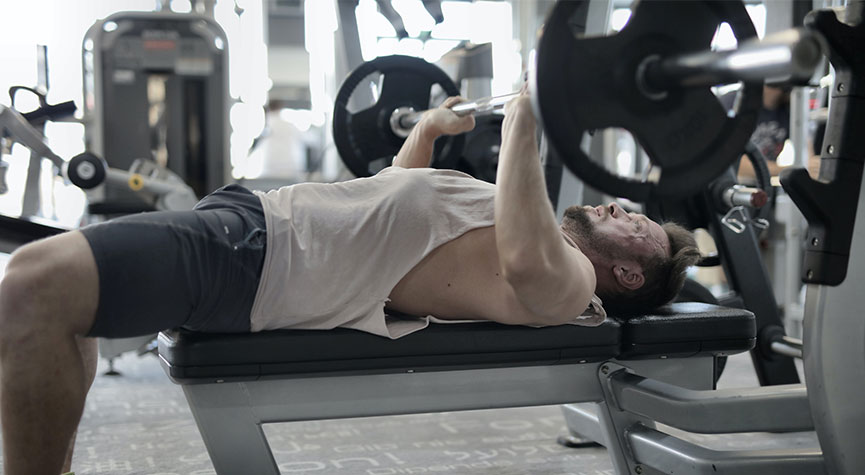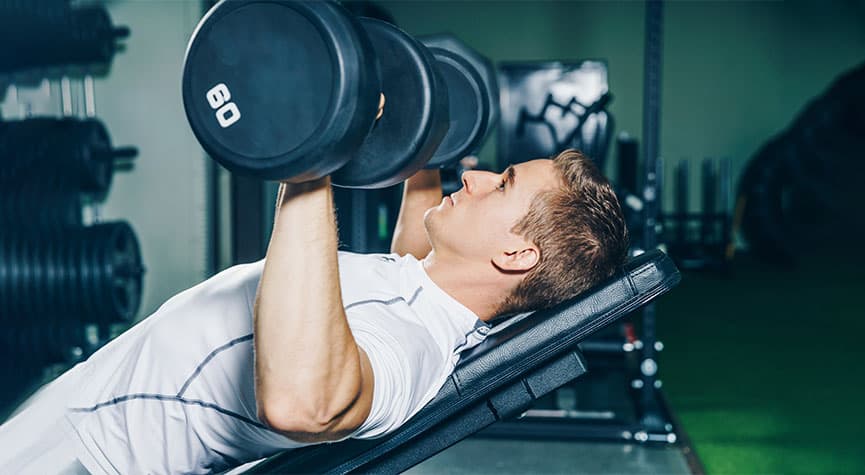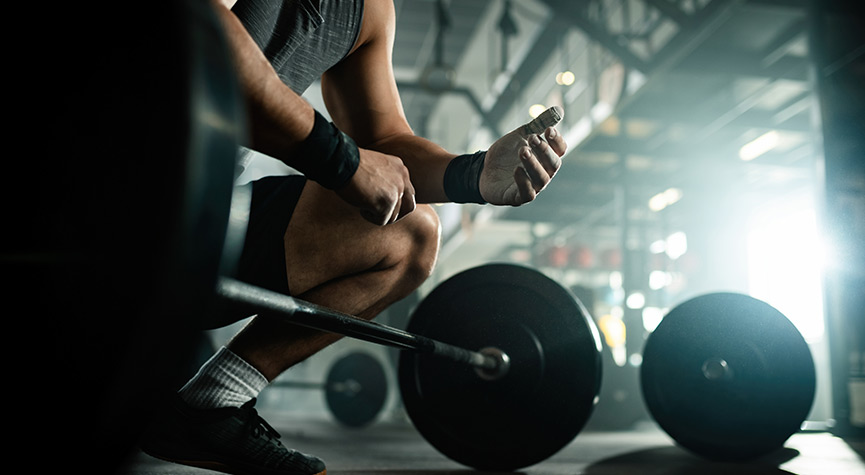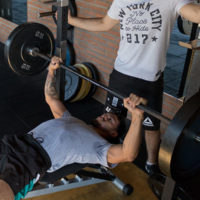In the vast landscape of strength training, few exercises command as much respect and admiration as the bench press. Hall of fame powerlifter Brad Gillingham is here to explain why it’s so popular and different variations to try.
The bench press is arguably the most popular upper body strength training movement. “How much do you bench” is the first thing most people ask you when they figure out that you lift weights.
Bench Press Breakdown
The bench press is a compound, multi joint upper body exercise that primarily involves the pectoralis major, anterior deltoid and the triceps brachii.1 Additionally, those that bench for maximum weight will find ways, through body position, to get the traps, and lats involved. Most athletes will start lifting weights by bench pressing.
I can remember a time back in high school when benching two plates was a badge of honor, and then the race was on to see who could get to 300 lbs. first. The bench press is a key component of any strength training program that focuses on building upper body strength and size.
The bench press is an exercise utilized by mainstream athletes, competitive strength athletes, bodybuilders, weekend warriors and fitness enthusiasts. It can be performed with different variations to focus on targeting the deltoids, pecs, and triceps from different angles, ranges of motion (ROM) and different points of leverage. This common exercise is found in programs developed for football, hockey, track and field, wrestling, combative sports, rugby, La Crosse, basketball, volleyball, and the list goes on.
The NFL uses the bench press as a test of upper body strength and endurance by having athletes at the NFL combine complete as many reps as possible with 225 lbs. This record belongs to Justin Ernest, Eastern Kentucky University, who completed 51 reps in 1999.2
The Competition Bench Press
The bench press is one of three disciplines along with the squat and deadlift performed in powerlifting contests and is often contested by itself. It is so popular that the International Powerlifting Federation (IPF) even has a separate world championship for the bench press.
The first meets that I lifted in were bench press meets. These meets were mainly unsanctioned but included some rules for completing the lift. I found out in a hurry that I could lift much more in the gym with a bounce off the chest, and my butt raised. But by competition standards you are required to keep your butt to in contact with the bench, and pause on the chest.
There are two divisions for competing in the bench press in the IPF, equipped and classic. Equipped refers to the use of a specialty designed supportive bench press shirt and classic involves no specialty bench press shirt. When I first started competing in the 1980’s bench press shirts provided very limited gains. They were light weight in construction, helped a lifter pause the bar and they provided support for the shoulders and pecs.
Technology evolved over time and the heavy-duty bench press shirts came into the IPF in 2002. This drastically changed the lift. With some lifters reporting 100-300 lb. gains. Unfortunately, I could not change my old school training techniques and never gained much of an advantage from the new shirts. As a result, I went from being a perennial bench press gold medalist at the IPF Worlds to finishing in the middle of my bench flight.
Thankfully I had a strong deadlift to make up the difference. To illustrate the difference in performance; the IPF World Record in the super heavyweight class with a bench shirt (equipped) is 938 lbs., and the IPF Classic World Record without bench shirt (non-equipped) is 661lbs.3
Bench Press Grip
There are different variations of grip width that can be utilized when training the bench press. Altering grip width can lead to increased activation of the primary movers.
For instance, a study indicated that the triceps are activated more when training with a narrow or medium grip, whereas the shoulders and pecs are activated more when training with a wide grip. 4 To maximize your 1RM most lifters will benefit from a medium to wide grip.
Therefore, my heavy training format is generally multiple sets of 3-5 reps with a moderate to wide grip in the 80%-90% range. However, I like to include a close grip light speed training day with 8 sets of 2 at 60-70 % of my 1RM to improve my lockout strength.
Bench Press Training Variations
I’m a big proponent of partial ROM training with super maximal training loads. My father introduced me to this style of training at an early age. I use this method to help train all three of the powerlifts. Partial ROM or rack presses are a great alternative training method to use heavier training loads above what you could do in a full ROM lift.
Research indicates that partial ROM training above the sticking point of the lift can improve your bench lockout.5 This is performed by putting a bench in a power rack and lifting the weight off of the pins. I generally recommend limiting your range of motion to 4-6 inches which is above the sticking point in the lift.
The incline bench press (IBP) is a bench press variation that will place a higher level of muscle activation on the anterior deltoids and less on the pectoralis major.1 The IBP may be a great addition for offensive linemen, boxers, and throwers. Bodybuilders train with this lift to pack on muscle in the front deltoid and upper pecs.
The barbell floor press (BFP) or unilateral dumbbell floor press (UDFP) are great movements to train additional pressing volume, but place less strain on the shoulders by limiting the ROM. With aging shoulders I can’t train with the same bench press volume that I did when I was younger. The UDFP is one of my favorite assistance exercises for the shoulders and triceps. I usually perform 3 sets of 10 reps. We use the UDFP a lot with our wrestlers that develop sore shoulders during the season.
Give Bench Press a Try!
If you’re not training the bench press you need to start. There are so many different variations that you can include into your workout to target different muscle groups. There is a ton of information on the web to help you execute these lifts with proper form. If you’ve quit bench pressing due to shoulder pain, give the unilateral dumbbell floor press a try. Good Luck and Stay Strong!
Want to get the most out of your training? Try myHMB.
MyHMB has been clinically proven to improve recovery, build muscle and strength, and enhance aerobic capacity. Learn more.
References
- Rodríguez-Ridao D, Antequera-Vique JA, Martín-Fuentes I, Muyor JM. Effect of five bench inclinations on the electromyographic activity of the pectoralis major, anterior deltoid, and triceps brachii during the bench press exercise. International Journal of Environmental Research and Public Health. 2020;17(19):7339. doi:10.3390/ijerph17197339 View Abstract >
- Reardon, L. (2023, March 6). NFL Combine Bench Press: Who did the most reps? what’s the record? NBC Sports Chicago View >
- Powerlifting records. IPF – International Powerlifting Federation. Accessed January 4, 2024. View >
- Larsen S, Gomo O, van den Tillaar R. A biomechanical analysis of wide, medium, and narrow grip width effects on kinematics, horizontal kinetics, and muscle activity on the sticking region in recreationally trained males during 1-RM bench pressing. Frontiers in Sports and Active Living. 2021;2. doi:10.3389/fspor.2020.637066 View Abstract >
- Massey, D. C., Vincent, J., Maneval, M., Moore, M., & Johnson, J.T. (2004). An analysis of full range of motion vs. partial range of motion training in the development of strength in untrained men. Journal of Strength and Conditioning Research, 18(3), 518-521. View Abstract >














